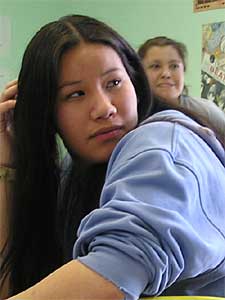It's been nearly five years since congress passed the No Child Left Behind Act. There's debate over whether the plan is improving education in schools. There's particular concern about how No Child Left Behind is affecting American Indian students. Some experts say the education mandate may be eroding progress made in recent years by reservation schools.
 |
| Nicole Boswell dreams of being a psychologist and working on the reservation. (MPR Photo/Dan Gunderson) |
Ashley Stevens is 17 and like many of her fellow students at Circle of Life, she's changed schools often.
" I've been to Park Rapids, I've been to four schools in Fargo Moorhead, I moved to California and went to school there. I've just been to a lot of schools," says Stevens.
That's a common story in reservation schools. Lot's of students moving around, and lots of students dropping out. . . .
. . . .The focus on tests and standards is hurting American Indian students, according to Director of the Center for Indian Education at Arizona State University David Beaulieu.
Beaulieu says as schools become more focused on tests, the American Indian dropout rate is increasing. He says reservation schools need to focus on more than a student's academic performance.
"The issues that face young people outside of the school, we have to pay attention to them. I suppose that's another aspect of culturally based education, understanding what the heck is going on and engaging them beyond the school wall," says Beaulieu.
Beaulieu says reservation schools need more flexibility to create schools where kids are valued and given a reason to stay in school. He says American Indian students generally learn better with an interactive setting rather than listening to classroom lectures.
That opinion is reinforced by the Circle of Life students. When asked what they would do to make school better, they choose more group projects rather than individual study. . . .
No comments:
Post a Comment